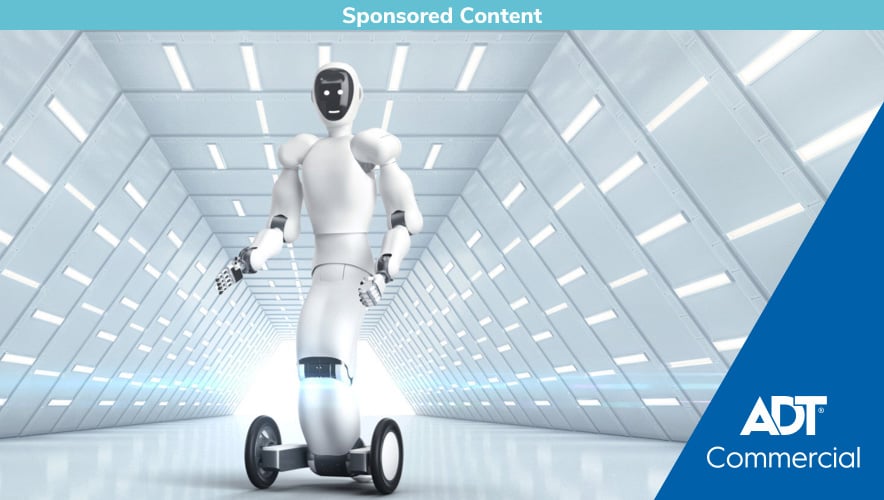Benefits of Humanoid Robotics in Guarding
Arguably, there is no emerging security technology since IP-addressable security devices on LANs and WANs that can change the nature of how commercial security is provided than AI-enabled robots. We’ve witnessed astonishing progress in recent years, and it’s become increasingly apparent that the inevitability of AI-enabled, humanoid robots in commercial environments will soon be a part of our here and now—and not too long after that, may be considered a necessity to a successful security program.
Emerging humanoid robots in commercial security
Robotic workforces are found in many industries, with visionary technology leaders like Jeff Bezos and Elon Musk adopting various robot forms for warehouse and line manufacturing production. These robots are distinctly non-humanoid; they’re purpose-built to perform exact and repetitious tasks with little to no error and often look like industrial machines. These robots work beside their human counterparts, and studies show that they can increase human productivity by multiples of hundreds.
Robots are already making our lives better and streamlining operations for businesses—and it’s becoming clearer through real-life applications that they’re not disrupting workers’ livelihoods as some people once feared. Importantly, these robot types have limited interaction with people. They carry out their selected task, and workers do theirs, and the touchpoints are often few. Given this, can the same be said for emerging humanoid robotics technologies?
In society, robots have a variety of scientific disciplines dedicated to their study, and human robotic interaction (HRI) is a science unto itself. People have emotional reactions to shapes and objects, and we unconsciously evaluate, categorize and judge items we encounter in our environment. Context plays a major role in our evaluations. When we need to interact with robots, we want a more familiar and socially relevant experience[1], especially when communicating with them.
For human-inspired robot designs, the interactions can be the entire spectrum of our daily lives: in our workplace, in our homes, and in institutions where they assist with caregiving and other daily tasks. Currently, the humanoid robotics issue is much less about workplace acceptance and more about the degree to which robots appear like us—meaning the degree that they are still machine-looking versus a synthetic human appearance.
Advantages in security applications
Researchers don’t universally agree about machine-like versus synthetic humanoid robotics form factors, but there is general agreement on several key fronts that apply to the commercial security industry. For security applications, a humanoid robot has several distinct advantages and uses over other form factors. For instance, it’s becoming clearer through real-life applications that the value they can provide is substantial as the next-generation response to guarding. AI-enabled security robots can navigate within their environment and independently perform programmed tasks, making them intensely helpful in bolstering a facility’s overall security program and both complementing and increasing the effectiveness of traditional guarding services.
Benefits of Humanoid Robotics in Guarding
How can humanoid robots change the game in securing commercial facilities? Consider the following benefits:
- Humanoid robots are constantly alert, minimizing the potential for human-like error.
- Humanoid robots can independently navigate their environment and perform programmed tasks with minimal human oversight, including conducting routine patrols and clearing safety hazards.
- Deploying humanoid robots can help reduce human exposure to life-threatening risks or hazards.
- Built for human and situational interaction, humanoid robots can help to address rising labor costs and shortages associated with the guarding market and increase operational efficiency.
- Designed to recognize and interact with people in an authorized environment, robots can communicate wayfinding requests or connect with a standby human operator to ensure accuracy and responsiveness when an incident occurs.
- Humanoid robots can be sent in to assess dangerous situations, such as a fire incident in a building or a suspicious package, protecting the lives of guards that must evacuate immediately, and providing critical information to first responders.
Humanoid security robots are here, and the good news is they’re now being designed to fit how we want to work with them. As we look to envision the security operations of the very near future, not only will purpose-driven humanoid robots offer the security services and value that security leaders are looking for, but their ability to positively engage with people and put them at ease cannot be overstated.
To learn more about how ADT Commercial is exploring the use of humanoid robotics and other groundbreaking emerging technologies in commercial security applications, visit our website, or visit us next month at GSX booth 2143 to see our innovations in-action.
[1] “The Social Perception of Humanoid and Non-Humanoid Robots: Effects of Gendered and Machinelike Features” by Steven J. Stroessner and Jonathan Benitez, International Journal of Social Robotics, April 2019. https://tinyurl.com/yvdcykb2
Sponsored content by ADT Commercial












